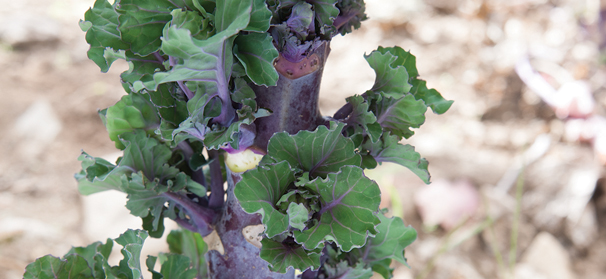

Dec 16, 2014Kalettes hit market for vegetable growers
It’s a newer vegetable that’s making early inroads into some sectors of commercial production, and those involved in the development and nurturing of Kalettes anticipate more acceptance as their popularity takes hold.
Kalettes, labeled by some as the “new kale,” were developed through traditional breeding methods by crossing kale and Brussels sprouts. Just like Brussels sprouts, the plants are tall and produce crops of florets on their stalks. Kalettes are late: their maturities range from 110 days to 138 days, depending on the variety.
Kalettes are new and improved, earlier varieties of the late-maturing bicolor sprout in the kaleidoscope flower sprouts mix. While flower sprouts only have one harvest slot late in the season, the three varieties of Kalettes offer early, mid and late maturities.
Johnny’s Selected Seeds introduced the new Kalettes seed in the fall to direct-to-market commercial growers and avid home gardeners across the United States and Canada, under an exclusive partnership with Tozer Seeds.
“What’s so interesting about them is they have a nice, mild, slightly sweet taste if they grow into the fall,” said Steve Bellavia, product technician at Johnny’s. “One of the good things is there’s really nothing like that on the market now. It’s adaptable to a number of cooking styles. It can be roasted, sautéed, steamed.”
Bellavia said the biggest challenge for growers is the “really long growing season. It needs high fertility and adequate moisture. Also, be aware that the plants grow quite large before the florets form, so patience is required when growing this crop. It takes a little longer than some growers think.”
While direct seeding is possible, it is recommended to transplant these crops. Johnny’s recommendation is to sow two to three seeds per cell in 72-cell plug flats, one-quarter-inch deep, four to six weeks before transplanting. When they’re ready, they should be transplanted with 18-inch spacings between plants in rows 24 inches apart.
“The exact timing of sowing will vary depending on your location and the season in which you wish to harvest,” Bellavia said.
Bellavia said Kalettes haven’t been susceptible to any unique disease or pest pressure that other brassicas would encounter.
“This is our first year of selling Kalettes,” Bellavia said. “Judging by how well the flower sprouts (introduced to the market in 2010) did, these probably will do well in the open market. We’re looking at a market for smaller growers, or for chefs in specialty markets and farmers’ markets.”
Bellavia said Kalettes develop in a whorl of tightly spaced, brilliantly colored rosettes on stalks of tall, upright plants, just like Brussels sprouts. The mature florets feature ruffled, purple-green petals with a mild, sweet-nutty flavor that only improves as the cooler, shorter days of fall give way to winter. Kalettes are suited to diverse preparation methods such as grilling, steaming, sautéing, stir-frying and roasting. When lightly cooked they retain their unique coloration and plate appeal.
Kalettes’ three bicolor varieties are specifically slated for sequential harvest slots. Autumn Star is first to produce for early season harvest; Mistletoe is for the midseason harvest slot; and Snowdrop is available to meet late-season demand. All three can be planted for an extended harvest program. The early crop requires a minimum of 110 days to mature from time of transplanting.
“Kalettes grow best in cooler weather, especially when forming florets, but will perform well in areas with mild summer weather prior to floret formation,” Bellavia said. “In areas with hot summers, the crop can be transplanted in late summer for successful fall, winter and spring harvest.”
From seed to edible floret, total time required for production ranges from 15 to 19 weeks.
The result of 15 years of traditional breeding work by Tozer Seeds of Britain, Kalettes have been extensively trialed across the United States. Johnny’s Selected Seeds began trialing kale-Brussels sprouts crosses with Tozer as early as 2009.
Kalettes seed became available for purchase from Johnny’s on Oct. 1.
“We started trialing Kalettes seeds a few years ago in the states after successfully launching them in the U.K. as flower sprouts,” said Lisa Friedrich, U.S. spokeswoman for Tozer Seeds, the largest family owned vegetable breeding company in England “This year we reached out to specific growers who had shown interest in the crop, and worked together to develop the Kalettes brand.
“The reason for this is that Tozer Seeds wanted to be sure that consumers were able to easily find the vegetable under a consistent name and branding in the grocery store,” Friedrich said. “Kalettes is a registered trademark name, and we are in the middle of the PLU application period for the vegetable, which will be generically known as kale sprouts.
“Small growers can purchase the seed through Johnny’s Selected Seeds,” Friedrich said. Large seed purchase inquiries should be sent through the contact form at this website.














